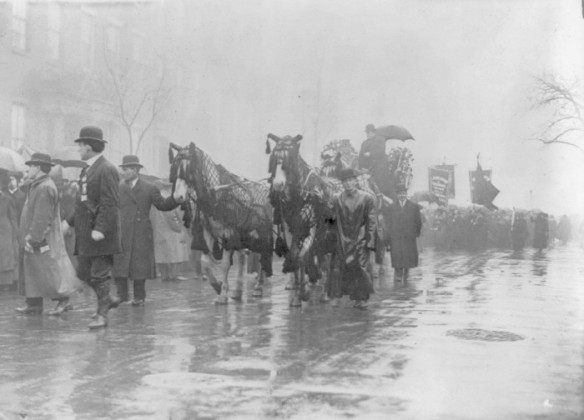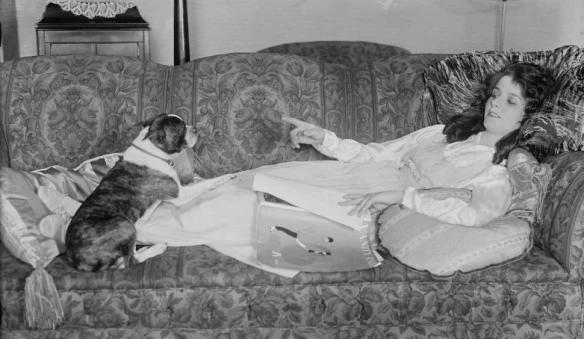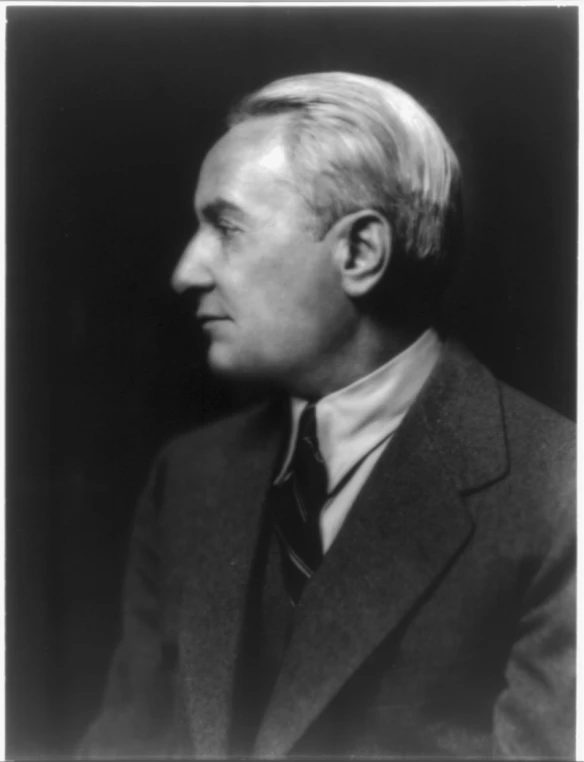Monday, March 25th, 2013 passed for most people as an ordinary day. People went to work and returned home safe and sound, but 102 years ago, the day ended differently for a group of workers in New York City. Some of them have never left the building they died in.

Asch Building (1911)
Image courtesy of the Library of Congress
The Asch Building (foreground above), at the intersections of Washington Place and Greene Street, housed the Triangle Shirtwaist Factory on its top three floors in 1911. A shirtwaist was the name for the blouses made popular by the Gibson girls in that era.

Artist: Gibson, Charles Dana, 1867-1944 Courtesy of the Library of Congress
The executives offices were located on the 10th floor. The 8th and 9th floors were large open spaces with most of the sewers occupying big long rows of machines on the 9th. Most of the employees were young, immigrant women who counted themselves lucky to be sewing rather than standing for 14 hours in a department store or in a dangerous, stifling commercial laundry. Still they worked 52 hours or more a week, Monday through Saturday producing 10-12,000 shirts a week.
Moods ran high on March 25th, 1911 because quitting time came sooner on Saturdays. On the 8th floor at 4:40 p.m., as employees gathered their coats and belongings, supervisors started to pass out paychecks, and someone threw a cigarette butt into one of the bins. The tissue paper and scrap fabric burst into a ball of fire. People grabbed buckets of water that were on hand as required, but the materials were too flammable, rendering the water useless. The flames quickly engulfed the main exit area, so people ran to the rear exit, but workers had to wait for a manager to come and unlock the door. Brave elevator operators made as many trips as possible until the fire blocked their way. Someone on the 8th floor alerted the 10th floor executive offices of the fire, but the switchboard operator then dropped the phone, leaving no one able to call the 9th floor.
Most of the people on the 10th floor followed the owners through the dense smoke in the main stairwell to the roof. They were dismayed to find that their building was shorter than the New York University building next door. Fortunately a professor, leading a lecture, noticed the fire, and he and his students rushed to the roof and lowered ladders rescuing everyone there.

Sewing room, shirt factory, Troy, N.Y. –
Image courtesy of the Library of Congress
The sewers worked in a room that encompassed the building’s entire ninth floor, similar to the Troy, NY factory depicted above. Machines hummed until 4:45 p.m. when the quitting bell sounded. That’s when the fire reached them. Flame and smoke blocked the main entrance, so people rushed to the only other staircase but found the exit door locked. No one had a key.
Some of the girls remembered the fire escape that hung on the inside airshaft of the building. Fire danced up from the eighth floor making it a harrowing journey down. The rungs measured only 18 inches wide. Abe Gordon, a button puncher, saw that there were no exits at the bottom of the air shaft, so he kicked through a 6th floor window. As he pulled his foot off the balcony, his clothes smoking, he heard a grinding screech followed by shrill screams as the fire escape collapsed, sending 24 souls to their death by falling onto the spiked iron fence at the bottom or through the basement skylight.

Image courtesy of the Library of Congress
Firemen arrived at 4:47 p.m. to bodies crashing to the pavement. They looked up to see faces pressed against the ninth floor windows with flames behind them. The firemen extended their ladder to the sky, but it stopped at the sixth floor, 30 feet too short. They held out catch blankets for the jumpers, but the force of the fall ripped the blankets from the rescuers hands, and most victims died on impact.

Image courtesy of the Library of Congress
One woman, surrounded by flames, tossed her new hat into the air, dumped her money on to the crowd below, and jumped. Another man helped women up on to the windowsill, so they could jump. One of the women he embraced tightly and gently lowered her to her death. A United Press reporter, William Shepherd, who arrived with the first fire truck, described the man “…as if he were helping them into a streetcar instead of into eternity.” Twenty-one people jumped from the Washington Place side of the building, while another thirty-three jumped or fell from the Greene Street side.

Image courtesy of the Library of Congress
The last body fell at 4:57 pm. Seventeen minutes after the fire began, 146 people were dead or dying. Most were young women between the ages of 16 and 23. Authorities established a morgue on the pier at East 26th Street, opening the doors to the public at midnight. Through the night wails of grief echoed in the cavernous space as more than 6,000 people an hour wandered “Misery Lane”.

Image courtesy of the Library of Congress
The Asch Building, now the Brown Building belonging to New York University, still stands and has a history of hauntings. People of have smelt burnt flesh, smoke, and heard screams in foreign languages. Some have seen bodies on the sidewalk. A woman has been seen running in terror down the hallway. A friend of mine who attended NYU did not experience such dramatic events, but she did say that there were unexplained noises, lights would turn on and off, and the energy of the building was very somber and oppressive.

Image courtesy of the Library of Congress
Until September 11th, 2001, the Triangle Shirtwaist fire was the deadliest workplace disaster in New York’s history in terms of loss of life. Although the evidence indicated that supervisors locked the workers in, the factory owners, Max Blanck and Isaac Harris, were found not guilty of manslaughter. They would later lose a civil suit and owe $75 per victim.
The victims though did not die in vain. This event shaped the future of New York City, and fire equipment and fire codes changed for the better. Out of the ashes Unions grew more powerful and so too worker’s rights. No longer could workers be locked in their work place. Every year on March 25th, the city’s unions pay their respects at the intersection of Washington Place and Greene Street, and the fire trucks arrive and shoot their ladders to the sky to say that we will never forget.

Trade parade in memory of fire victims – Image courtesy of the Library of Congress













